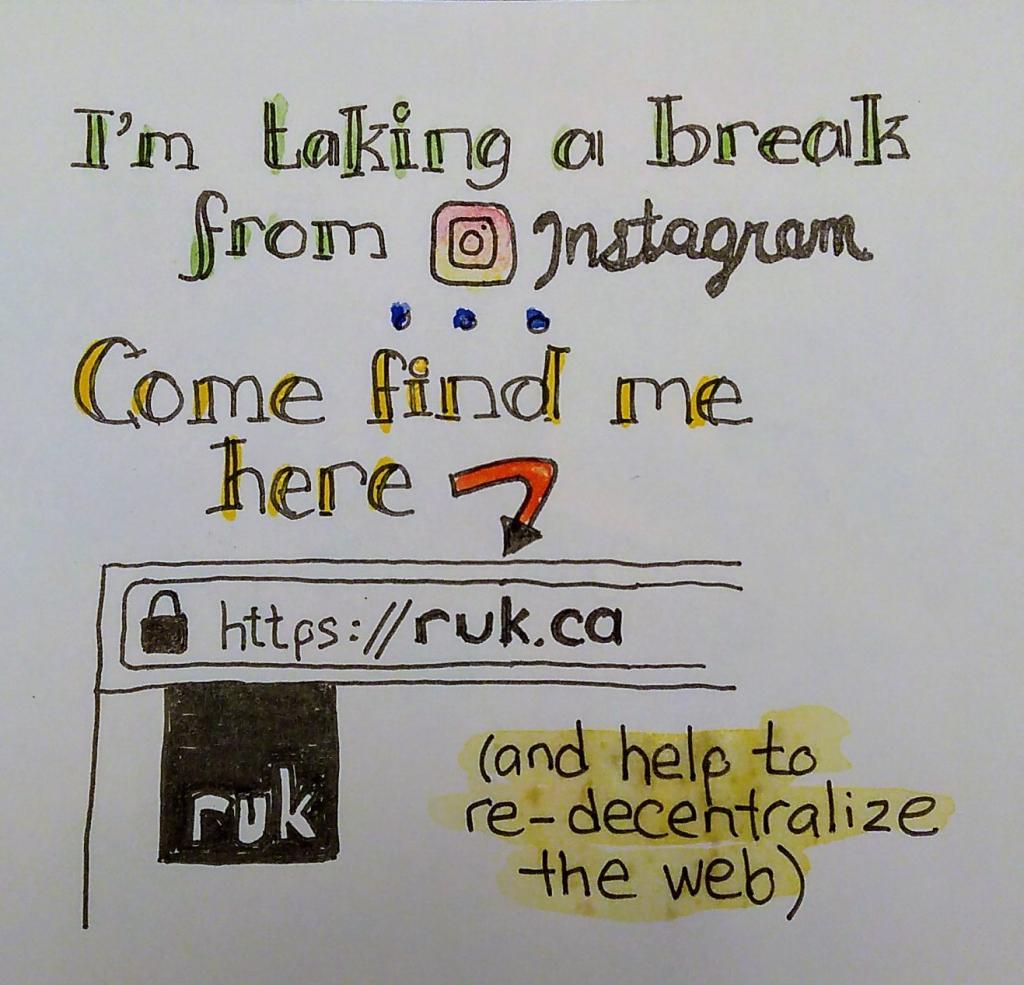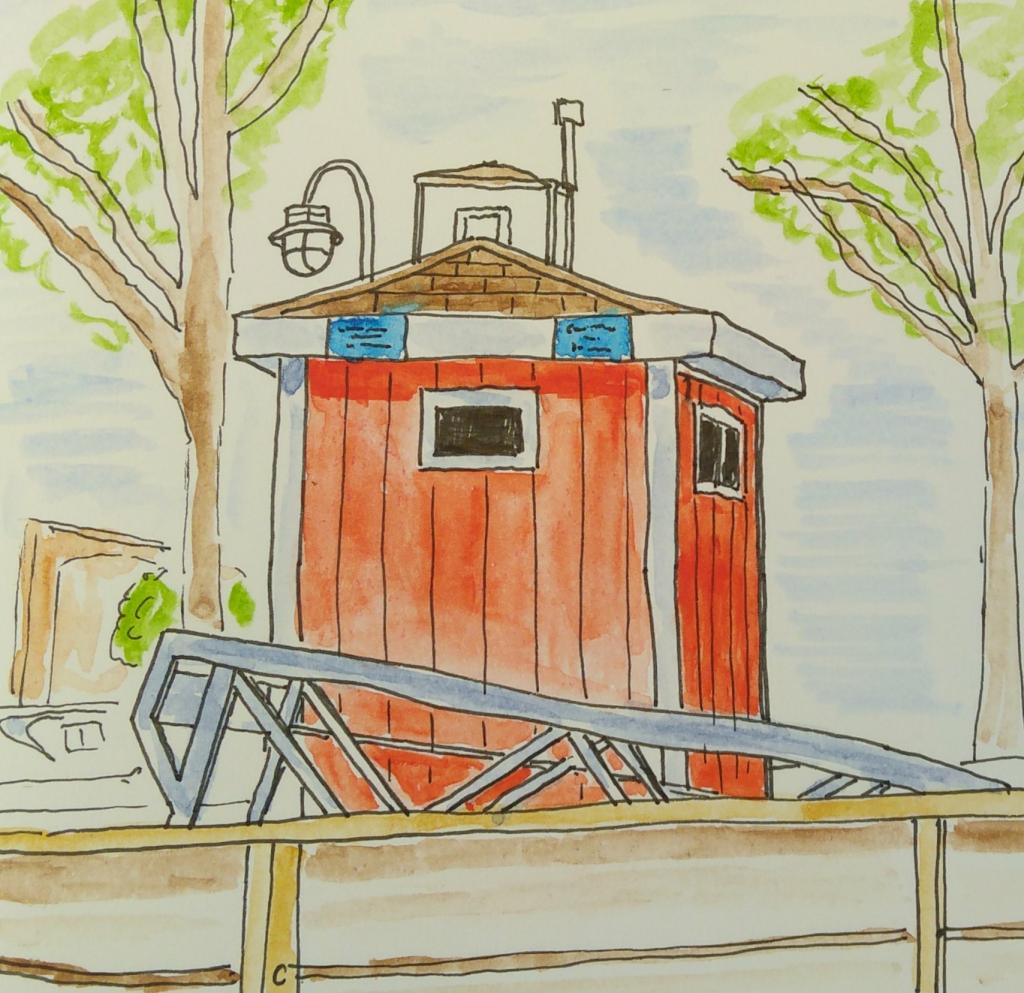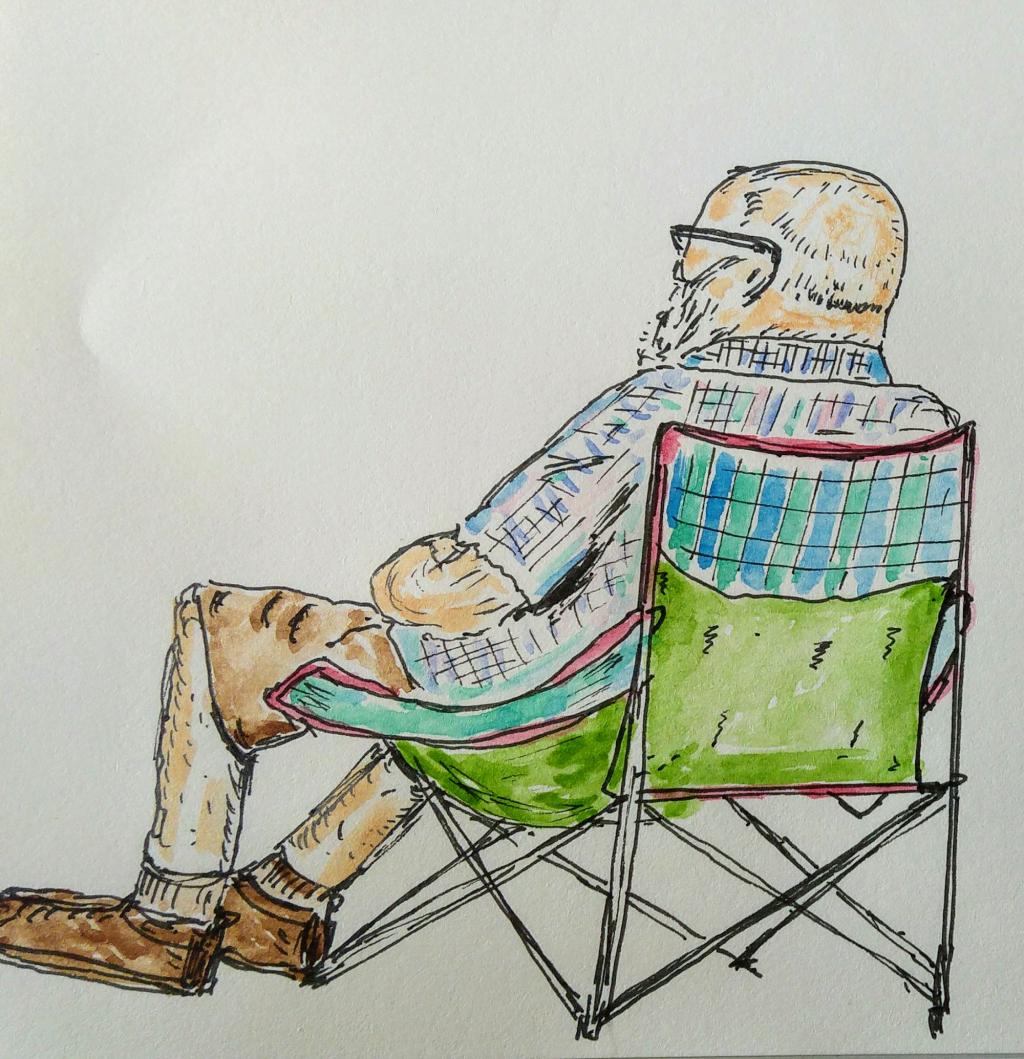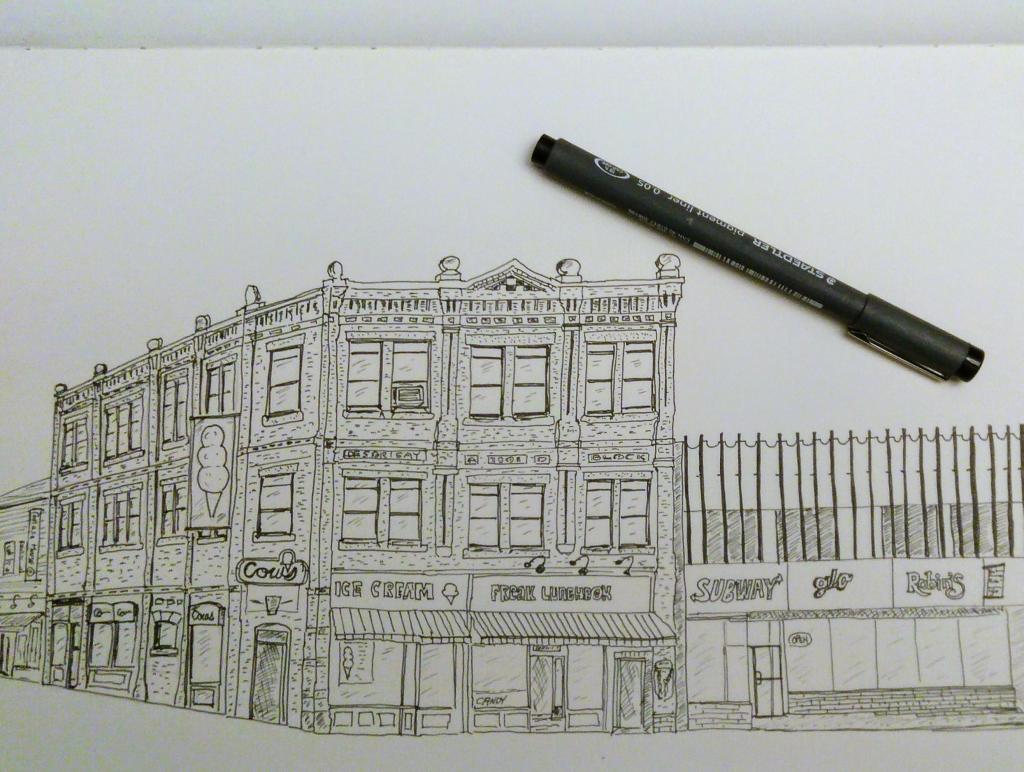After I successfully decamped from Twitter and Facebook earlier this year, I continued to hang around Instagram.
It was casual at first, but then I started posting sketches, and I found myself a nice little community of sketchers along with a generous bunch of friends ready to hit the “like” more often than deserved.
What poisoned me on Instagram, though, was the advertising, which I find more insidious than elsewhere because it just pops up in the timeline exactly like everything else, leveraging my openness of mind and spirit to the photos of my friends and familiars to insert commercial messages. That hurts my brain. Every single time.
As I need to keep reminding myself, we built a decentralized web, and nurturing it requires that we use it.
So that’s what I’ll continue to do. Here.
That I need to keep rediscovering this impulse is a testament to the allure of the centralized, and of the need to examine what’s missing from the independent web that makes straying so easy.

There’s a new coffee place, Java Moose, floating at Quartermaster Marine at Peake’s Wharf. It’s got a pleasant, sunny deck that’s arguably the most scenic place to get coffee in town.
I sat there this afternoon and sketched the boat tours booth next door, a booth that went through a bright orange retrofit last year.

On Sunday afternoon at Cloggeroo I was sitting just behind Leo Cheverie, who’d set down his lawn chair and tucked in for some excellent Island folk music. I’m very happy with the Leoness of the result.

Oliver finished the second of his two shifts as photographer at the Cloggeroo folk festival today; he was warmly embraced by the Cloggeroo family, and it all went swimmingly.
My badge said “Assistant Photographer,” and that’s what I was; it was a nice way to be at the festival, helping Oliver excel at something new.
Cloggeroo, meanwhile, has proved a revelation: we saw some amazing bands there over the last two days, bands I never would have expected. As we heard echo from the stage, just as we were leaving, “this ain’t no ceilidh.” And it ain’t.
Day three is tomorrow: no volunteering for us, just civilian audience life. If you’re looking for a pleasant way to spend Sunday afternoon, please join us.

I needed to get some cash to pay Oliver’s support worker, so I stopped at the ATM in The Guild on my way out the door today.
It’s been a long day, and I’ve worked hard on multiple projects; my brain isn’t at 100%. And so I put my MasterCard in the ATM instead of my credit union account card.
Because the PIN number is the same for both, I was able to blithely proceed with a withdrawal before I noticed what I’d done.
So what I got was a “cash advance” on my credit card.
I had a vague memory of reading that interest applies immediately to cash advances, so I called my credit card issuer to confirm this, and to find out how I could put the money back.
Long story short: I can’t.
Well, I can, but credit card payments work on a “last out, last in” basis, so to pay back the $200 cash advance I received means first paying back my entire outstanding credit card balance of $1800; only then do I start paying back the cash advance.
And even if I do this, I’m still out the $2 fee the ATM charged me, the $4 that my credit card issuer charges up front for cash advances, and a few days worth of interest on the $200.
Fortunately the ATM only allows withdrawals of $200 at a time, so the damage was limited.
But it’s a cautionary tale, one that will make me pay more attention the next time I groggily withdraw cash.
From the Dictionary of Canadian Biography entry on Theophilus Desbrisay (emphasis mine):
Theophilus Desbrisay’s appointment as governor’s chaplain for St John’s (Prince Edward) Island was obtained for him in 1774 by his father, the lieutenant governor. A student at Trinity College, Dublin, Theophilus was already in deacon’s orders. He was ordained to the priesthood by the bishop of Waterford on 3 July 1775, although he was not yet of canonical age, and he then set out for Charlottetown. In the Strait of Canso the vessel on which he was a passenger was captured by American privateers who had just plundered Charlottetown. Following his release, he arrived late in the year at the capital only to discover that there were no funds for his support and the £3,000 allocated by the crown in 1772 for construction of a church, court-house, and jail had been appropriated by Governor Walter Patterson to pay government salaries.
You’re on your way to Charlottetown when your ship is captured by pirates who had just plundered Charlottetown.
What are the odds!
It was on that same plundering trip that the original Great Seal of Prince Edward Island was stolen, never to be returned, a tale summarized well in Canadian Symbols of Authority: Maces, Chains, and Rods of Office:
During the American War of Independence, two American schooners, the Hancock and the Franklin, sailed into Charlottetown Harbour. On 17 November 1775, the Island’s administrator (acting governor), Phillips Callbeck, along with the surveyor general, Thomas Wright, immediately went down to the beach to meet what they assumed were two fishing vessels. To their surprise they were promptly taken prisoner by Captain John Selman and Charlottetown was sacked by the Americans.” Everything ofvalue was purloined, including the island’s massive Great Seal, which was made of sterling silver. Callbeck and Wright were released in January 1776, and George Washington apologized for their ordeal.” The Great Seal, however, was never returned.
Callbeck and Wright’s letter to George Washington provides a complete account of the attack; Washington wrote to John Hancock about it as well.
If you are an American reader of the blog, and have privateers in your family history, could you please check your attic for the Great Seal.
My first sketch in a Paper-oh A4 sketchbook, I started over lunch on the patio at Casa Mia with the right side of the COWS building. I added the former Henderson & Cudmore storefront on my way home, and finished the rest of the COWS building, running up Queen Street, after Oliver was off to bed (working from photos).
It’s an entirely different experience sketching on A4 after four months of the much smaller A6: having the extra room both allows more detail and allows for more material.
I’m happy with the result, although I have a list of things I wish I’d done better for the next time.

Seventeen years ago this month Catherine was entering her 8th month of pregnancy. We’d just moved into our house at 100 Prince Street, and complicated, dusty renovations were underway. For Catherine it was a hot, uncomfortable summer, and it was my job to try to make things better.
One August night I went along to the video rental store to get a movie, thinking that would be a good distraction. I came home with a VHS tape of Angela’s Ashes, the film adaptation of Frank McCourt’s book of the same name. I thought it would be a light summer romp through Ireland.
I was wrong.
Here’s the introduction to the Spark Notes summary of the book:
The narrator, Frank McCourt, describes how his parents meet in Brooklyn, New York. After his mother, Angela, becomes pregnant with Frank, she marries Malachy, the father of her child. Angela struggles to feed her growing family of sons, while Malachy spends his wages on alcohol. Frank’s much-loved baby sister, Margaret, dies and Angela falls into depression. The McCourts decide to return to Ireland. More troubles plague the McCourts in Ireland: Angela has a miscarriage, Frank’s two younger brothers die, and Malachy continues to drink away the family’s money.
Careful readers will note that packed into that one brief paragraph is one baby death, the death of two children, and one miscarriage.
Angela’s Ashes, in other words, is not the film you want to watch while you are uncomfortably 8 months pregnant.
A few weeks later, we were over for supper at a friend’s house; sharing the table with us were a couple from Boston, old friends of our host. As the evening progressed, I took the opportunity to relate the story of my ham-handed movie curating.
One of the old friends, perhaps not understanding the larger message of my story, decided this would be a good jumping-off-point for a detailed description of every horrible thing that had ever happened to any of her parents’, grandparents’, cousins’ and in-laws’ pregnancies. “My dear old Aunt Gertie had 17 miscarriages,” she might have said (the details escape me), “including several involving packs of rabid wolves.”
I think of that night often, and I thought of it again this afternoon when I came across a pointer from Jason Kottke to 10 ways to have a better conversation, a TED talk by journalist Celeste Headlee.
Number 6 of the 10 is:
Don’t equate your experience with theirs.
In the video, Headlee elaborates:
If they’re talking about having lost a family member, don’t start talking about the time you lost a family member. If they’re talking about the trouble they’re having at work, don’t tell them about how much you hate your job. It’s not the same. It is never the same. All experiences are individual. And, more importantly, it is not about you. You don’t need to take that moment to prove how amazing you are, or how much you’ve suffered.
I am an offender in this regard as much as anyone: I’m not naturally comfortable relating to other people, and in my discomfort I’ll often reach for an “oh, X happened to you – X happened to me too!”
Sometimes this is fine: it can be a way of establishing common interests, or common struggles; often, though, I should follow Headlee’s advice, and let their X stand on its own, without a need for buttressing by my X.
Since Catherine was diagnosed with metastatic breast cancer three years ago, I’ve had a lot of uncomfortable conversations about cancer.
More than once, while accompanying Catherine to the PEI Cancer Treatment Centre for an appointment, I’ve run into someone I know in the waiting room, someone obviously there for cancer treatment for themselves or a loved one. What do I say?
Conversely, the last three years saw a gradual unflowering of the news of Catherine’s cancer through our community of friends, coworkers, acquaintances, and people we’ve never met before but who seem to know us.
I meet someone on the street who I haven’t seen in a few years; they know about Catherine’s cancer, but we’ve never talked about it. What do they say?
A couple of weekends ago the brake pad warning light came on in our Volkswagen. On Monday morning, I took the car into the shop and Dave, my mechanic, diagnosed the issue as being a stuck caliper on the left side. So while the brake pads on the right were almost brand-new, and had years worth of life in them, on the left side the pads were worn down to the thickness of a couple of quarters. Dave replaced the pads and the rotors, and the busted caliper, and by the end of the day I was on my way.
I’ve related my brake pad adventure a few times in the weeks since, and it’s never proved to be an uncomfortable conversation. None of the friends I’ve told the story to have felt compelled to tell me the story of their brake pads. Or how their father’s brake pads failed once and he plummeted to his death.
But brake pads are not cancer. Cancer is about life and death and struggle and suffering and hospitals and mystery. And talking about it seems almost necessarily uncomfortable. And so we run to conversational tropes to try to rescue ourselves from the discomfort.
Fortunately, despite the shroud of stress that surrounds talking about cancer, the 10 ways to have a better conversation are helpfully universal, and can work for cancer conversations as much as for any other:
- Don’t multitask.
- Don’t pontificate.
- Use open-ended questions.
- Go with the flow.
- If you don’t know, say that you don’t know.
- Don’t equate your experience with theirs.
- Try not to repeat yourself.
- Stay out of the weeds.
- Listen.
- Be brief.
Reading through that list I realize that I’m not particularly accomplished at any of them, although I’m trying. Headlee says number 9, “Listen,” is the most important, and I agree: we’re not very good at listening, most of us, especially when there is quiet to be filled up, and it’s in not listening where things often go off the rails.
Which is all to say that the way to talk to people about cancer is the way to talk to people about anything else.
Go with the flow. Ask open-ended questions. Stay out of the weeds. Listen.
Stuck?
Here’s a good place to start:
How are you?
Mediamatic is one of my favourite things. If I lived in the Netherlands, I would be there every day, and go to every event.
In September it is hosting The Chromatic Dinner:
We are all familiar with how food tastes in our mouths, but can we also experience food through a different sense? Can you feel the sound of water, the smell of metal, the taste of fire or the texture of earth? Artist Martin Butler and vegan chef Alexander Gershberg present a wholesome and harmonious eating experience. Inspired by the Chinese five elements, each course is designed in a different color. Interested in the way in which color, smell, texture, sound and taste are mixed together? Join us for this fully immersive second edition of Mediamatic’s Neo-Futurist Dinners.
Under “practicalities” it is noted that “All Neo-Futurist Dinners are vegan.”
This seems like a good, general, rule.
My route into Mediamatic was via the content management system that undergirds its digital manifestation; this was also the CMS that ran the reboot website back in the 1960s, and I’ve always found it intriguing (I should probably update my profile).
Thirteen years ago on this day I wrote about Nagasaki:
The threat of nuclear destruction is still here today (nuclear powers would have you think it’s from terrorists; my money is on the nuclear countries themselves, through accident or intent), it’s just faded into the background.
Oliver is almost four years old now. He doesn’t know about Hiroshima or Nagasaki or the Holocaust or the Bataan Death March or any of the innumerable other inhumanities we have committed on each other. I am stymied when I think of how to begin to tell him. “Sorry, Oliver, humankind isn’t as great as I led you to believe originally…”
And now not so much in the background.
 I am
I am